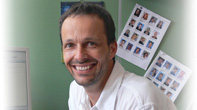


 |
 |
 |
|---|
IdentificationThe easiest way to identify me is the number "4184020564" - my Austrian social security number. But this does not tell you a lot about me ... EducationI started out studying theoretical physics at the University of Innsbruck. My diploma thesis was on "Two-photon excitation of Rydberg-states close to the ionization threshold" (1988) , which outlines the boundary between the world of quantum processes, where electrons are defined by wave-packets, and the classical world, where electrons behave as particles. I was really lucky, and had the chance to do my thesis with Peter Zoller, one of the leading scientists in the world of quantum optics, and one of the best teachers I have ever met. He also gave me the possibility for an extended research stay at JILA (Jount Institute for Laboratory Astrophysics) in Boulder, Colorado. For his research he received in 2005 the Max Planck medal, the highest award for physicists in Germany. After my reseach stay in Boulder I went to the ETH in Zurich, where I started out with experimental work on solid state lasers, and computersimulations on laser cooling of atomic beams with Juergen Mlynek (who is now head of the "Helmholtz-Gemeinschaft Deutscher Forschungszentren", the larges research organisation in Germany). From there, Klaus Hepp and Volker Henn, who had started the Vestibulo-Ocular laboratory in Zurich (where I did my PhD), enticed me to a change in my research field, and introduced me into the field of neuroscience. Under their combined guidance, I did my PhD in Biophysics, about "Listing’s law as an organizational principle for eye-, head-, and arm-movements" (1992). Klaus Hepp was a leading mathematical physicist when in the mid seventies he decided to turn his attention to finding out how the brain works. His results in mathematical physics are still among the most powerful that exist; for example, he provided a complete algorithmic proof of the Bogoliubov-Parasuik renormalisation procedure. For his research work, he received the Max Planck medal in 2004. His open attitude, his brilliant mind, and his contagious curiosity about all aspects of life has made him one of my roll models. He prodded me on when I needed it (for example, his comment to the first version of my PhD-thesis was "I hope you have not shown this to anyone else!").After three years of post-doctoral research at the University of Sydney (with Ian Curthoys and Michael Halmaghi), and another three years in Tuebingen (with Michael Fetter) I returned to Zurich, where I collaborated with Dominik Straumann. Again with support from Klaus Hepp, I got my habilitation in the field of Biophysics, with a thesis on "Computational and Experimental Aspects of Rotatory Eye Movements in Three Dimensions" (2001). Interests For most of my adult life I have seen myself as a mointaineer, a Tyrolian, and a researcher - in this sequence. A serious climbing accident in 2001 turned my life upside down, and now I would list mountainbiking, photography, and reading as my main interests outside work. If you are interested, you can find out more about me and my interest on my private homepage. |
| Thomas Haslwanter, last updated June 24, 2012 |
|---|